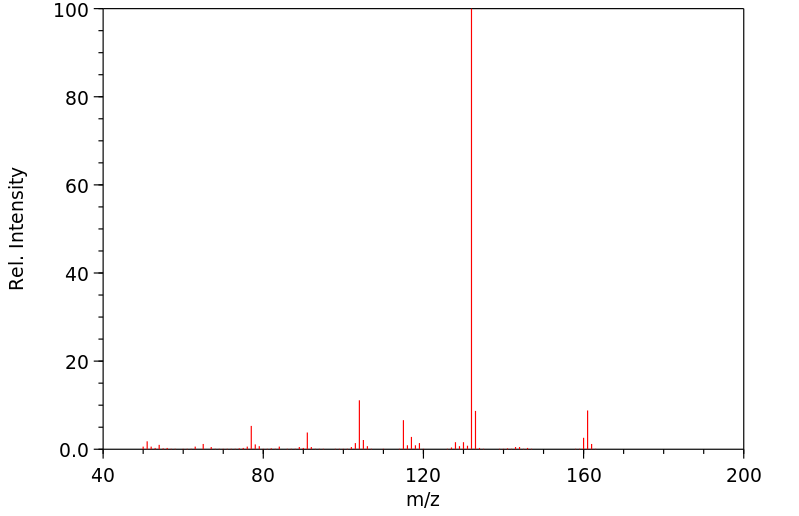N-环戊基苯胺 | 40649-26-1
中文名称
N-环戊基苯胺
中文别名
——
英文名称
N-cyclopentylaniline
英文别名
——
CAS
40649-26-1
化学式
C11H15N
mdl
——
分子量
161.247
InChiKey
WEULTTCXSOUGPM-UHFFFAOYSA-N
BEILSTEIN
——
EINECS
——
-
物化性质
-
计算性质
-
ADMET
-
安全信息
-
SDS
-
制备方法与用途
-
上下游信息
-
文献信息
-
表征谱图
-
同类化合物
-
相关功能分类
-
相关结构分类
物化性质
-
沸点:137 °C(Press: 12 Torr)
-
密度:1.0202 g/cm3
计算性质
-
辛醇/水分配系数(LogP):3.2
-
重原子数:12
-
可旋转键数:2
-
环数:2.0
-
sp3杂化的碳原子比例:0.45
-
拓扑面积:12
-
氢给体数:1
-
氢受体数:1
SDS
反应信息
-
作为反应物:参考文献:名称:仲N-烷基苯胺的催化选择性氧化偶联:一种偶氮芳烃的方法。摘要:叠氮芳烃是有机分子中重要的支架之一。初级苯胺的直接氧化偶联为构建它们提供了一种简洁的方法。然而,这些支架是否可以由仲N-烷基苯胺制备尚未得到很好的研究。在这里,我们提出了在温和条件下仲N-烷基苯胺催化选择性氧化偶联以提供具有钨催化剂的叠氮芳烃。另外,a氧基可被视为烯烃和酰胺的生物等排体。相应的生物活性烯烃和酰胺的几种“偶氮芳烃类似物”显示出可比的有希望的抗癌活性。DOI:10.1021/acs.orglett.9b01200
-
作为产物:描述:N-(cyclopentylidene)aniline 在 甲醇 、 sodium tetrahydroborate 作用下, 反应 7.0h, 以25.5 mg的产率得到N-环戊基苯胺参考文献:名称:使用PhI(OAc)2和Cs 2 CO 3氧化伯胺的氧化重排摘要:本文报道了由高价碘(III)试剂介导的伯胺的氧化重排。证明PhI(OAc)2和Cs 2 CO 3的组合在诱导伯胺从1,2-C向N的直接迁移方面非常有效,可用于制备无环胺和环胺。机理研究表明,重排通过协同机制进行。DOI:10.1021/acs.orglett.9b00559
文献信息
-
Chan–Evans–Lam Amination of Boronic Acid Pinacol (BPin) Esters: Overcoming the Aryl Amine Problem作者:Julien C. Vantourout、Robert P. Law、Albert Isidro-Llobet、Stephen J. Atkinson、Allan J. B. WatsonDOI:10.1021/acs.joc.6b00466日期:2016.5.6The Chan–Evans–Lam reaction is a valuable C–N bond forming process. However, aryl boronic acid pinacol (BPin) ester reagents can be difficult coupling partners that often deliver low yields, in particular in reactions with aryl amines. Herein, we report effective reaction conditions for the Chan–Evans–Lam amination of aryl BPin with alkyl and aryl amines. A mixed MeCN/EtOH solvent system was found
-
Cobalt(II) Phthalocyanine-Catalyzed Highly Chemoselective Reductive Amination of Carbonyl Compounds in a Green Solvent作者:Vishal Kumar、Upendra Sharma、Praveen K. Verma、Neeraj Kumar、Bikram SinghDOI:10.1002/adsc.201100645日期:2012.3.16Cobalt phthalocyanine has been employed for the highly chemoselective reductive amination of aldehydes and ketones in ethanol as a green solvent. A large range of functional groups such as nitro, acid, amide, ester, nitrile, halogen, lactone, methoxy, hydroxy, alkene, N‐benzyl, O‐benzyl and heterocyclic rings were well tolerated under the present reaction conditions.
-
Direct reductive amination of carbonyl compounds using bis(triphenylphosphine) copper(I) tetrahydroborate作者:Mayur J. Bhanushali、Nitin S. Nandurkar、Malhari D. Bhor、Bhalchandra M. BhanageDOI:10.1016/j.tetlet.2006.12.037日期:2007.2A direct reductive amination protocol for aldehydes/ketones using bis(triphenylphosphine) copper(I) tetrahydroborate as a novel reducing agent in the presence of sulfamic acid has been developed. The reagent chemoselectively reduces the imine moiety and does not affect other reducible functionalities such as chloro, nitro, cyano and methoxy.
-
Palladium-Catalyzed Formal Cross-Coupling of Diaryl Ethers with Amines: Slicing the 4-<i>O</i> -5 Linkage in Lignin Models作者:Huiying Zeng、Dawei Cao、Zihang Qiu、Chao-Jun LiDOI:10.1002/anie.201712211日期:2018.3.26ether bonds (α‐O‐4, β‐O‐4, and 4‐O‐5 linkages) and other C−C bonds. Among the ether bonds, the bond dissociation energy of the 4‐O‐5 linkage is the highest and the most challenging to cleave. To date, 4‐O‐5 ether linkage model compounds have been cleaved to obtain phenol, cyclohexane, cyclohexanone, and cyclohexanol. The first example of direct formal cross‐coupling of diaryl ether 4‐O‐5 linkage models
-
Reductive Alkylation of Aromatic Amines with Enol Ethers作者:T. Jagadeeswar Reddy、Michael Leclair、Melanie ProulxDOI:10.1055/s-2005-863704日期:——Reductive alkylation of aromatic amines with 2-methoxypropene using 1.0 equivalent of HOAc and NaBH(OAc)3 in 1,2-dichloroethane (DCE) at room temperature furnished N-isopropyl amines in 50-98% yields. This method was successfully extended to trimethylsilyl enol ethers. The mild reaction conditions provide a new alternative procedure for the reductive amination of electron deficient aromatic amines
表征谱图
-
氢谱1HNMR
-
质谱MS
-
碳谱13CNMR
-
红外IR
-
拉曼Raman
-
峰位数据
-
峰位匹配
-
表征信息
同类化合物
(乙腈)二氯镍(II)
(R)-(-)-α-甲基组胺二氢溴化物
(N-(2-甲基丙-2-烯-1-基)乙烷-1,2-二胺)
(4-(苄氧基)-2-(哌啶-1-基)吡啶咪丁-5-基)硼酸
(11-巯基十一烷基)-,,-三甲基溴化铵
鼠立死
鹿花菌素
鲸蜡醇硫酸酯DEA盐
鲸蜡硬脂基二甲基氯化铵
鲸蜡基胺氢氟酸盐
鲸蜡基二甲胺盐酸盐
高苯丙氨醇
高箱鲀毒素
高氯酸5-(二甲氨基)-1-({(E)-[4-(二甲氨基)苯基]甲亚基}氨基)-2-甲基吡啶正离子
高氯酸2-氯-1-({(E)-[4-(二甲氨基)苯基]甲亚基}氨基)-6-甲基吡啶正离子
高氯酸2-(丙烯酰基氧基)-N,N,N-三甲基乙铵
马诺地尔
马来酸氢十八烷酯
马来酸噻吗洛尔EP杂质C
马来酸噻吗洛尔
马来酸倍他司汀
顺式环己烷-1,3-二胺盐酸盐
顺式氯化锆二乙腈
顺式吡咯烷-3,4-二醇盐酸盐
顺式双(3-甲氧基丙腈)二氯铂(II)
顺式3,4-二氟吡咯烷盐酸盐
顺式1-甲基环丙烷1,2-二腈
顺式-二氯-反式-二乙酸-氨-环己胺合铂
顺式-二抗坏血酸(外消旋-1,2-二氨基环己烷)铂(II)水合物
顺式-N,2-二甲基环己胺
顺式-4-甲氧基-环己胺盐酸盐
顺式-4-环己烯-1.2-二胺
顺式-4-氨基-2,2,2-三氟乙酸环己酯
顺式-3-氨基环丁烷甲腈盐酸盐
顺式-2-羟基甲基-1-甲基-1-环己胺
顺式-2-甲基环己胺
顺式-2-(苯基氨基)环己醇
顺式-2-(苯基氨基)环己醇
顺式-2-(氨基甲基)-1-苯基环丙烷羧酸盐酸盐
顺式-1,3-二氨基环戊烷
顺式-1,2-环戊烷二胺二盐酸盐
顺式-1,2-环戊烷二胺
顺式-1,2-环丁腈
顺式-1,2-双氨甲基环己烷
顺式--N,N'-二甲基-1,2-环己二胺
顺式-(R,S)-1,2-二氨基环己烷铂硫酸盐
顺式-(2-氨基-环戊基)-甲醇
顺-2-戊烯腈
顺-1,3-环己烷二胺
顺-1,3-双(氨甲基)环己烷







